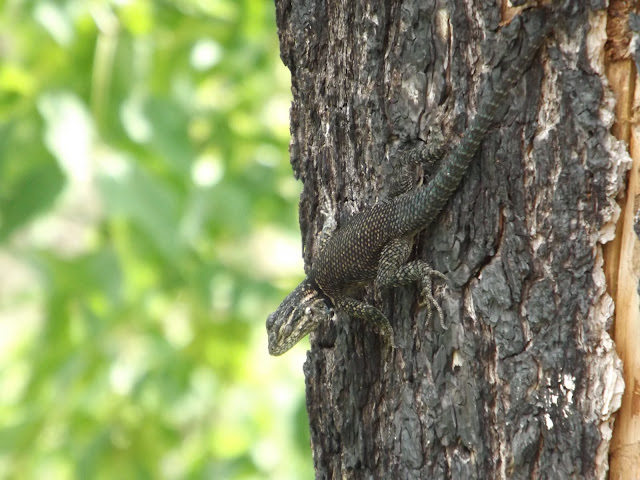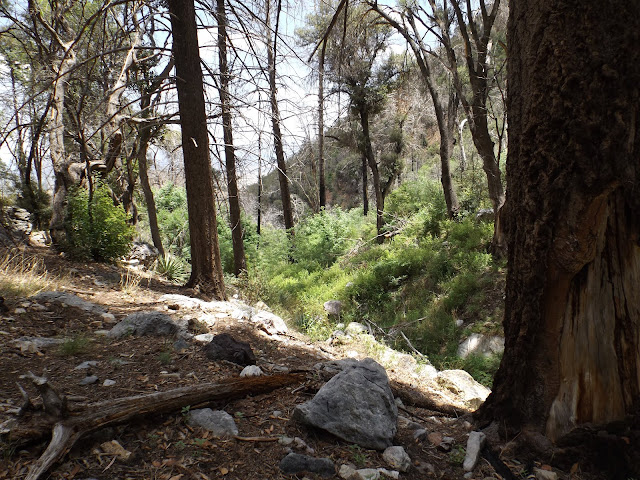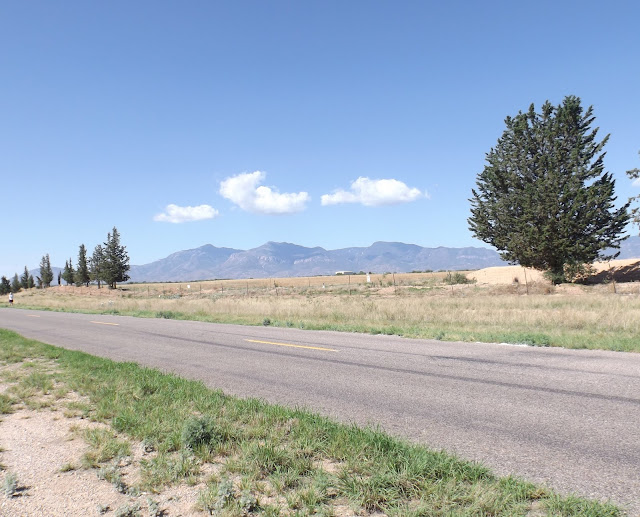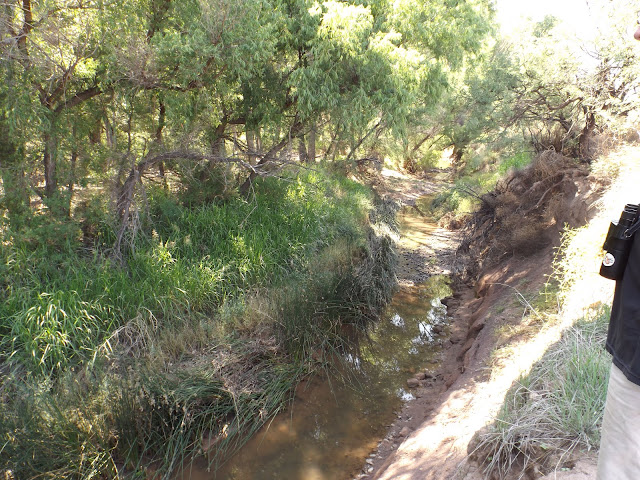As per usual this summer, my friend Caleb gave me an unexpected invitation to bird with Gordon Karre, Susan Fishburn, and him in Southeast Arizona! This would be my first all day rarity chasing trip as we were after a Purple Gallinule in Tucson, a Scissor-tailed Flycatcher in Sierra Vista, and others. My parents okayed the trip and we were a go. Logistics worked out in a similar fashion as in in my last trip to the Organ Pipe Cactus NM.
Arriving at Caleb's house the evening before we were to leave, we talked and also got some sleep before waking to leave early the next morning. Susan picked us up and then we all carpooled with Gordon in his car. We knew it would be an eventful day!
Our first stop was in the Sierra Vista area along Moson Rd. There was a grove of cypresses that harbored one of the Arizona's best rarities of the year - a Scissor-tailed Flycatcher! When we saw the grove in the distance, we knew we were in the right place. We cautiously pulled over and walked along the road. There was another bird here that Caleb and I both needed. And we both heard it start to sing right when we started our hike to the cypress grove!
This bird is a Cassin's Sparrow an inhabitant of parts of the Southwest and Midwest. This species is well-known for its habit of 'skylarking'; a behavior in which a singing bird flies up from the ground and high in the air and then drops back down again, singing all the while. We went on to locate 7 Cassin's Sparrows before leaving. Another species of sparrow caught us off guard as well - a Botteri's Sparrow!
As excited as we were about these seemingly boring sparrows, we decided to shift focus to the bird we came to find! I scanned every branch of those cypresses and kept a wary eye searching over the grasslands in case the flycatcher was flying out there. Soon, Caleb had located the bird behind a cypress and we were all trying to get a visual on it. Then, it flew from the cypress and into plain sight!!! It was absolutely bizarre to see a bird with a tail that long fly successfully. The tail bounced up and down with ever flap of its wings. I honestly wonder why they aren't extinct. I mean, a raptor could totally outdistance the Scissor-tailed Flycatcher in flight...right? Awkward proportions aside, it was a magnificent bird. Normally they are found in the US primarily in Texas, Oklahoma, and Kansas. Southeast Arizona is a long ways off, but the habitat here was perfect for them. A few other birders got to see the bird and were absolutely thrilled at the sight of it.
Aside from the sparrows and epic flycatcher, there were plenty of other birds around.
 |
| A few Western Kingbirds were bothersome to the Scissor-tailed Flycatcher, the ravens, and pretty much anything else alive. |
 |
| In flight, a Chihuahuan Raven looks nearly identical to a Common Raven... |
 |
| But when preening, they give themselves away... |
 |
| Only Chihuahuan Ravens have white bases to their neck feathers. |
 |
| Watching the Scissor-tailed Flycatcher |
A flock of Mallards - some of which being the Mexican subspecies - flew by us on their way to a nearby pond. A couple Swainson's Hawks soared overhead. A Blue Grosbeak and Vermilion Flycatcher were also in the trees. On the other side of the road in the desert, we heard a Ladder-backed Woodpecker and a Crissal Thrasher.
After thoroughly enjoying the wonderful Scissor-tailed Flycatcher, we drove to the San Pedro House; a famed birding location along the great San Pedro River.
While Gordon and Susan decided to visit the hummingbird feeders, Caleb and I decided to walk the trails along the river and explore the mesquite bosques. The first thing I saw was a literal riparian wall; the imposing one I've ever seen.
 |
| Good to see these cottonwoods standing tall! |
There were also many Desert Grassland Whiptails throughout the entire area.
Once we reached the riparian area, we started noticing a lot of birds. Summer Tanagers were active as were many Yellow Warblers and Common Yellowthroats. A Gray Hawk flew from its perch and deep into cover before we could get any photos. One of the most impressive species here were the Yellow-billed Cuckoos. We were heard quite a few throughout the duration of our stay. A small family group of Bushtits were slightly unusual. Vermilion Flycatchers were the dominant flycatcher species in the area, even outnumbering the Brown-crested Flycatchers.
 |
| An underside view of a male Vermilion Flycatcher |
 |
| Also common were Common Ground Doves |
We took a different trail that was surrounded by thick mesquites and tall grass. Caleb heard a Willow Flycatcher and Indigo Bunting. Both excellent birds. We were especially looking forward to the possibility of Northern Beardless Tyrannulets, but that dream never came true. Instead, we located another Gray hawk - and this one was a younger individual.
 |
| The riparian wall |
When we met up again with Gordon and Susan, we heard about some the birds they had. They had just seen a Coachwhip snake - one that I hadn't seen before. Caleb and I tried relocating it, but to no avail.
We left the San Pedro House and headed towards the Huachuca Mountains. Caleb and I wanted to make the hike up Hunter Canyon to try to find a bird that is quite scarce and elusive: the Rufous-capped Warbler. Gordon and Susan decided to do some feeder watching nearby while we were hiking.
 |
| We faced a hike that would take us almost all the way to the top!! |
 |
| Do you see that dark ravine of trees on the front of the mountain? That's where the warblers can be found - if they're around... |
Although, the hike was only 1.3 miles, the gain in elevation took its toll on me! As we approached the point where the chaparral meets the coniferous drainage, we began to notice a lot more bird activity. We found found good numbers of Broad-tailed, Broad-billed, and Magnificent Hummingbirds, Northern Flickers, Western Wood Pewees, Buff-breasted Flycatchers, Dusky-capped Flycatchers, Woodhouse's Scrub Jays, Mexican Jays, Bushtits, Canyon Wrens, Bewick's Wrens, Painted Redstarts, Spotted Towhees, Black-headed Grosbeaks, and Scott's Orioles.
 |
| Dusky-capped Flycatcher |
Apart from the varied birdlife, there were also some interesting insects and plants...
 |
| A Pleasing Fungus Beetle (Gibbifer californicus) |
 |
| Tetraclonia dyari - a moth, not a beetle! |
 |
| Lycus loripes - a Net-winged Beetle |
 |
| Bigtooth Maple |
 |
| Mahonia |
 |
| An orange fungus which was probably attracting the fungus beetles. |
 |
| A Yarrow's Spiny Lizard |
In order to find a Rufous-capped Warbler, you must be patient. It's not a very noticeable bird although its coloration is striking. It skulks around in forest undergrowth typically no more than 3 feet from the ground. A song or call could be your only clue that the bird is present - or you might just have no clues at all. Caleb and I would stop awhile and listen. And after 5-10 minutes, we would move to a different spot and listen some more. We kept this up for maybe a half hour until we heard voices coming up the trail. Considering the area's proximity to Mexico, I was slightly nervous that the people we were going to encounter in a few moments would be smugglers. Thankfully, they were birders! The man introduced himself. He was a biologist from California who was in Arizona to bird with his sister and a friend. He too was searching for the Rufous-capped Warbler.
 |
| The lush drainage that the warblers prefer |
We heard a couple Montezuma Quail giving their descending "whirrr" calls from the hillside. While searching for the warbler, we heard a whistling song... "Jose" "Jose" "Jose Maria!" I knew what it was right away; my lifer Greater Pewee!!! In Latin America, they are known as "La Jose Maria" because of their song. The Greater Pewee is a bird I have longed wanted to see, but I only heard it. And that's ok by me. Honestly, I enjoyed hearing the bird more so than if I just saw a silent one. After our excitement over the pewee, I just began to talk about wildlife biology with the man we were birding with when Caleb yelled down the hill that he had the bird!!! I swiftly approached Caleb and everyone else followed suit. Caleb said it was up 7 feet or so in a fir. And it was; completely out of its usual habitat and character!
Everyone got to see it. It dissapeared after brief but good looks. What I love about my photo is that it's completely diagnostic yet out of focus.
Because Gordon and Susan would be waiting for us at the trailhead in 15 minutes, Caleb and I took off down the hill after saying goodbye to the other party.
 |
| A view from the top. |
Halfway down the mountain, we found a Sonoran Whipsnake - a swift and agile species. When we reached the trailhead parking lot, Gordon and Susan were already there. They hadn't been waiting for long which was good to hear. We had one stop left to make; we were going to look for the Purple Gallinule that was previously reported at the Sweetwater Wetlands in Tucson on our way back home. Purple Gallinules are a secretive marsh bird related to coots, moorhens, and rails. In my opinion, they are the most colorful of all rails in Northern America. They are typically found on the Atlantic coast, but occasionally, vagrants are found much further west. We arrived at Sweetwater around 4 pm and immediately set out in search of the gallinule.
 |
| A Cooper's Hawk perched on a sign was nice to see. |
A good assortment of marsh birds were at the wetlands; Neotropic Cormorants, Common Gallinules, Song Sparrows, and Yellow Warblers. Caleb spotted a Tropical Kingbird - a good species for here.
After nearly an hour of searching, we found no Purple Gallinule. But you know what? 2 for 3 is actually really good when it comes to rarity chasing! After a long and fruitful day, we each returned to our respective homes to get some rest. I ended the day with 4 lifers: Cassin's Sparrow, Scissor-tailed Flycatcher, Greater Pewee, and Rufous-capped Warbler. And I truly appreciated getting to know each of them.
Godspeed and good birding,
- Joshua


























No comments:
Post a Comment